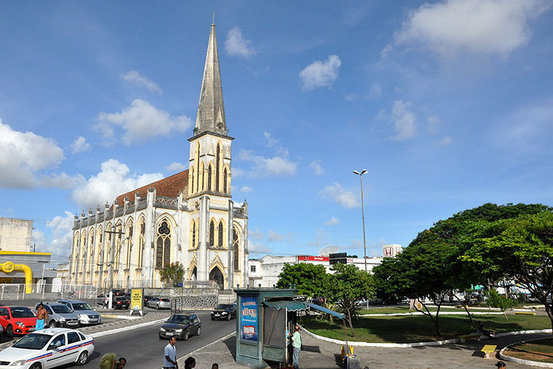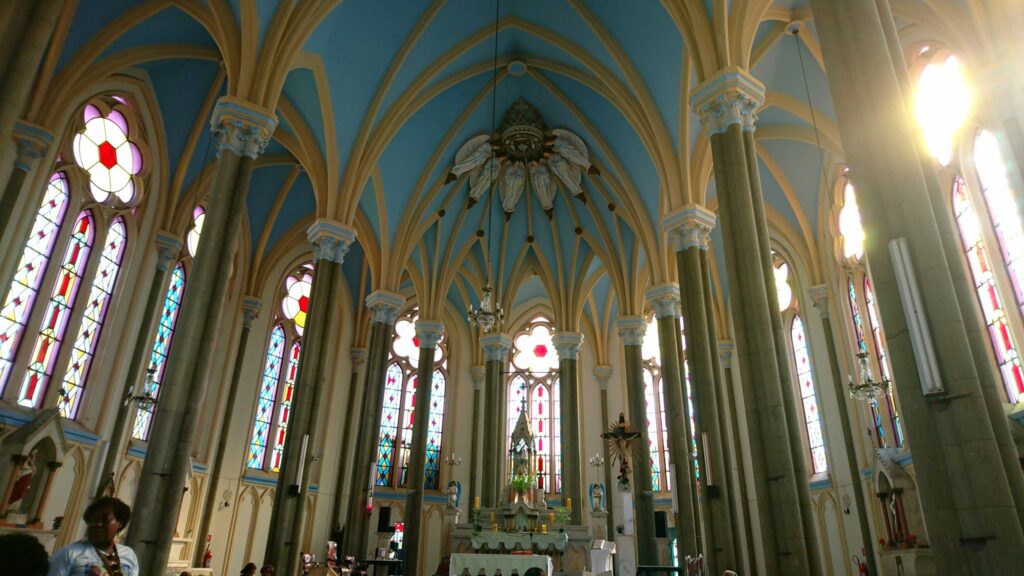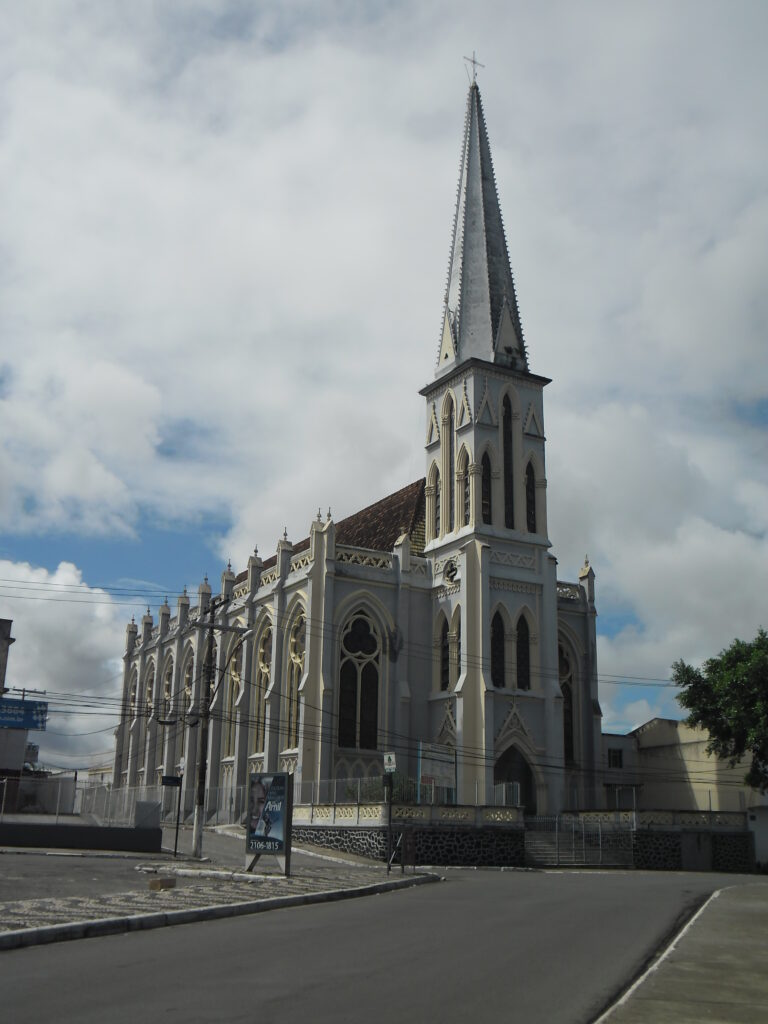Nossa Senhora dos Mares Church: A neo-Gothic heritage site in Salvador
The Nossa Senhora dos Mares Church, located in Salvador, Bahia, is an important religious and cultural monument of the city. Also known as the Church of Nossa Senhora dos Mares and São Pedro Nolasco, it is located in the Mares district, a traditional area of Salvador, close to the Lower Town.

Despite its importance, the church is not listed because it is considered new and has no significant historical facts associated with it.
Video about the Gothic style of the Nossa Senhora dos Mares Church

Igreja Nossa Senhora dos Mares em Salvador
See also Churches in Salvador de Bahia.
1. The history
The Gothic style emerged in the middle of the 12th century in France at a time of population growth and economic, commercial and urban development. This context allowed the rise of an urban elite and the affirmation of clerical power, both of which invested in the embellishment of cities with the construction of cathedrals and buildings that were indicators of their power and prestige, benefiting from advances in construction techniques.
The Nossa Senhora dos Mares Church is the only church in Bahia built in the Neo-Gothic style, characterised by elements such as
- Verticality: Tall, slender structures that create a sense of elevation towards the sky.
- Ogee arches: Point-shaped arches that help support the weight of the walls.
- Buttresses: External supports that strengthen the walls, allowing the structures to be thinner and higher.
- Towers and pinnacles: Tall, pointed towers, often topped with pinnacles, which add grandeur to the building.
- Stained glass windows: Large windows decorated with colourful stained glass, providing internal lighting and creating a spiritual atmosphere.
- Rosettes: Circular windows decorated with elaborate patterns, located on the main façade.
- Decorative elements: Ornamental details such as gargoyles and statues of saints that add complexity to the facades.
- Pyramidal Roofs: Accentuated roofs that resemble pyramids.
- Materials: Use of stone, brick and, in some buildings, reinforced concrete.
- Latin cross plan: Many neo-Gothic churches have a cross plan, symbolising the Christian faith.
The Carmelites built a chapel dedicated to Our Lady of the Seas in 1749. This chapel stood in the centre of the square in front of the present church. It wasn’t until 1871 that Captain Major Manuel da Costa Araújo and a group of believers built the parish.
The fourth vicar, Monsignor Anísio Ayres Esteves, took office in 1927, when the old parish was already showing signs of decay. During this period, the church was broken into by a young man from an influential family, who broke into the tabernacle and stole the solid gold ambo, throwing the wafers into the bushes outside the church. In 1930 the foundation stone was laid for the new parish church, dedicated to the Blessed Sacrament and the Secular Clergy. Worship began in 1937 with the transfer of the images and the procession of the Blessed Sacrament from the old church to the new one. Although the building work was still in progress, there was a considerable attendance, with around 180 baptisms every Sunday, as well as many weddings. The old parish church was later demolished and the current Praça Manoel da Natividade Maria was built in its place.

2. Architectural typology and elements
Reinforced concrete was used instead of stone in the construction of the parish church.
The exterior is notable for its verticality and symmetry, rhythmically marked by buttresses that end in pinnacles, interspersed with ogival windows in lace and iron, coloured stained glass with rose windows that illuminate the interior in a cheerful and special way, and decorated cornices.
The church has a single slender tower at the centre of the main façade, over fifty metres high. The tower has a series of windows and pointed pediments decorated with cogulhos below the main entrance, rising to a corbelling that ends in a cross. The main door is made of upholstered wood and has an ogival arch.
Another important aspect is the absence of pointed arches and a central rose window. The church has one main entrance and two side entrances.
The main nave, side aisles with marble altars dedicated to the saints Sacred Heart of Jesus, Senhor Bom Jesus dos Navegantes, St Joseph the Worker and Our Lady of Sorrows stand out in its hall-like layout.
The high altar is dedicated to Nossa Senhora dos Mares Church, and there is an ambulatory with a confessional and an access door to the sacristy, as well as a stone altar containing the tombs of the church’s first priests: Monsignor Manuel da Natividade Maria, Monsignor Anísio Ayres Esteves and Monsignor Vitalino de Munford.
To the right of the main entrance, a staircase leads to the choir. The floor is granite and the ceiling has cross and star vaults with chain link ogives resting on fascicled columns. The roof is carved with six angels with their hands around the coat of arms of the First National Eucharistic Congress.

Conclusion
The Nossa Senhora dos Mares Church is an outstanding example of neo-Gothic architecture in Bahia, reflecting the cultural and religious richness of Salvador. Its history, marked by important events, and its architectural typology make it a point of religious and tourist interest in the region.
Tourist guide to Salvador, Bahia and the Northeast
Publicações Relacionadas
Discovering the Origins of the Senhor do Bonfim Ribbons
Characteristics and History of the Church and Convent of São Francisco in Salvador
Discover the Charm: A Tour of Interesting Places in Salvador
Tourist Attractions in Pelourinho and the Historic Centre of Salvador
Fort of Santo Antônio da Barra and Its Rich History
Fort of Nossa Senhora de Monte Serrat History
Bahia Art Museum (MAB): Learn about its history and collection
Tourist attractions and architectural heritage in Salvador de Bahia
Ponta de Humaitá is one of the most charming places in Salvador
Secret History of Salvador de Bahia
Prostitution, Sex, Bars and Nightclubs in Salvador de Bahia
Exploring the Architectural Marvels: Churches of Salvador
History of the São Marcelo Fort or Forte do Mar in Salvador
Palaces in Salvador to visit and learn about Brazil's history
History and sights of Avenida Contorno in Salvador BA
Tourist attractions for children in Salvador de Bahia
Discover the 23 wonderful beaches of Salvador de Bahia
History of the Forts and Lighthouses of Salvador
This post is also on:
![]() Português
Português ![]() English
English ![]() Deutsch
Deutsch ![]() Español
Español ![]() Français
Français



















